Consequences
Broken bones
The most important consequence of osteoporosis is the frequent fractures after mostly harmless causes or – as we doctors say – after an inadequate trauma.
Inadequate trauma means either no recognizable external cause or, for example, only a harmless fall, whereby harmless usually means falling from a standing position onto the ground. Since osteoporosis is a systemic disease of the entire skeleton, this increased bone fragility naturally affects all bones.
The frequent limitation of typical osteoporotic bone fractures to forearm, vertebral and femoral neck fractures is partly due to historical reasons or is based, among other things, on the frequency (forearm and vertebral collapse) or the particularly serious consequences of vertebral and femoral neck fractures.
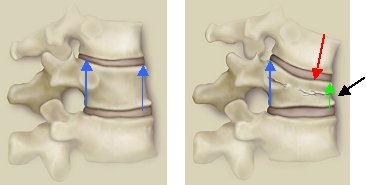
The vertebral collapse is the osteoporotic fracture par excellence, as it usually occurs without a recognizable cause (e.g. when lifting an object or bending down). With the exception of the vertebral and rib fracture, a fall or accident is a necessary prerequisite for any other bone fracture. Therefore, the distinction between a typical osteoporotic and a “normal” bone fracture due to an appropriate accident event is often not easy and unambiguous.
Even the vertebral fracture does not always have to be the result of osteoporosis, but can of course also be caused by an accident or severe fall, and more rarely, for example, by a benign or malignant tumor or metastases.
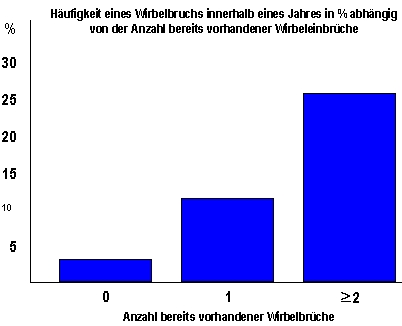 Das rechte Bild zeigt in der Mitte eine eingebrochene Deckplatte (roter Pfeil) am mittleren Wirbelkörper (WK), und zwar typischerweise im Bereich der Vorderkante (schwarzer Pfeil), was neben der Höhenminderung des betroffenen Wirbelkörpers auch eine Verkrümmung der gesamten Wirbelsäule nach vorne (verstärkte Kyphose) bewirkt.
Das rechte Bild zeigt in der Mitte eine eingebrochene Deckplatte (roter Pfeil) am mittleren Wirbelkörper (WK), und zwar typischerweise im Bereich der Vorderkante (schwarzer Pfeil), was neben der Höhenminderung des betroffenen Wirbelkörpers auch eine Verkrümmung der gesamten Wirbelsäule nach vorne (verstärkte Kyphose) bewirkt.
Die blauen Pfeile zeigen eine gleiche Höhe der Vorder- und Hinterkante beim gesunden WK links. Bei dem eingebrochenen WK rechts hat die Höhe der Vorderkante (grüner Pfeil) auf etwa die Hälfte der ursprünglichen Höhe abgenommen. (Bilder: Kyphon Inc. © 2000 Kyphon Inc.)
Typical vertebral body fractures
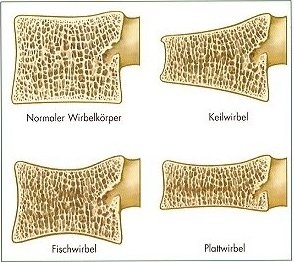
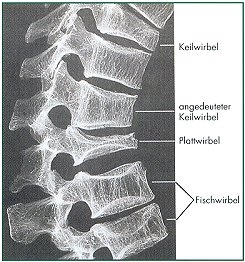 Depending on the shape of the vertebral collapse, we differentiate between “wedge vertebrae”, “indicated wedge vertebrae”, “flat vertebrae” or “compression vertebrae” or “fish vertebrae”. The two images show the various osteoporotic forms of vertebral body fractures, on the left in a typical X-ray image and on the right schematically (images courtesy of MSD Sharp & Dome GmbH). Wedge, fish and flat vertebrae occur mainly in the thoracic vertebrae (thoracic spine), fish and flat vertebrae predominantly in the lumbar spine area (lumbar spine).
Depending on the shape of the vertebral collapse, we differentiate between “wedge vertebrae”, “indicated wedge vertebrae”, “flat vertebrae” or “compression vertebrae” or “fish vertebrae”. The two images show the various osteoporotic forms of vertebral body fractures, on the left in a typical X-ray image and on the right schematically (images courtesy of MSD Sharp & Dome GmbH). Wedge, fish and flat vertebrae occur mainly in the thoracic vertebrae (thoracic spine), fish and flat vertebrae predominantly in the lumbar spine area (lumbar spine).
In addition to the reduction in height of the collapsed vertebral bodies, the increasing number of vertebral collapses leads to both increased curvature (kyphosis) of the entire spine (“widow’s hump”) and a significant decrease in body size, which in extreme cases can be up to 20 cm and sometimes even more .
The pictures above left and in the middle show the same lady, on the left at the age of 50, on the right at the age of 75, but now with a visible “widow’s hump” and significantly reduced body size. The picture on the right shows a healthy (left) and a corresponding osteoporotic (right) spine with numerous vertebral collapses (arrows). (Original images courtesy of MSD Sharp & Dome GmbH, images left and center or Kuratorium für Bone Health, image right).
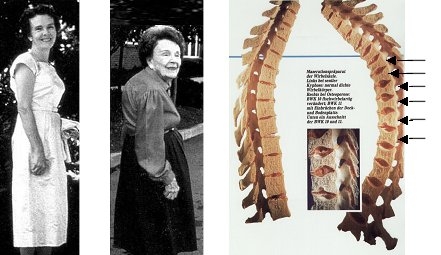
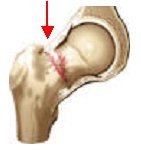
This is by far the most serious consequence of osteoporosis and mainly affects older patients over the age of 70. In up to 30% of all cases, the femoral neck fracture leads to death within half a year. More than half of the surviving patients remain condemned to long-term care despite treatment (usually the insertion of a prosthesis)! The picture shows the typical localization of a so-called femoral neck fracture.
The decrease in height and the curvature of the spine also lead to a reduction in the size of the chest cavity. This means that the lungs have less space to unfold, which causes a disruption of the respiratory function. A single vertebral fracture can reduce the functional lung volume by up to 10%! In the picture of the 75-year-old lady in the top center, the bulging of the abdomen can be seen very clearly because the chest organs (lungs, heart) are pushed down towards the abdominal organs. This also significantly reduces the distance between the lower costal arch and the iliac crest. The consequences are shortness of breath and more frequent lung diseases (e.g. pneumonia).
Back pain and shortness of breath lead to insomnia, restricted mobility and thus to isolation, anxiety, lack of independence and depression. The quality of life is thus considerably restricted. This reduction in quality of life is of course particularly pronounced after the most serious osteoporotic bone fracture, the femoral neck fracture.
Chronic back pain results in restricted mobility and increased bed rest (immobilization). Immobilization, in turn, causes bone loss even more quickly and thus the progression of osteoporosis. The pain increases and, as a consequence, so does the immobilization. This results in a further progression of osteoporosis with an increase in pain ……. and so on!
Recent studies have clearly shown that the presence of severe osteoporosis increases both the susceptibility to other diseases (morbidity) and the risk of death (mortality). This means that osteoporosis is associated with an overall reduced life expectancy, a fact that has so far mostly been swept under the table. Diseases with (direct or indirect) fatal consequences such as cardiovascular diseases, lung diseases, cancer, etc. are still considered far more important than osteoporosis. What does a broken bone mean compared to a heart attack or stroke? Even today, more hospital beds are reserved for the treatment of the femoral neck hernia than for the treatment of heart attack and stroke combined! But not only the femoral neck fracture, but also every vertebral collapse shorten (directly or indirectly) the remaining life time. “People are now dying of osteoporosis too” (quote freely based on Prof. Helmut Minne, Fürstenhof Clinic, Bad Pyrmont) – our health officials in politics and health insurance companies should finally be aware of this!
